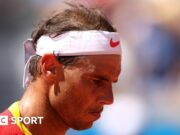A humanoid robot named Andi is pioneering advancements in sports technology at New Balance’s research lab in Boston. This remarkable creation sweats and breathes, with its heat sensors reacting to rising temperature and humidity levels, causing the 150 pores across its body to moisten. With a value of $500,000, the objective is to develop sportswear that effectively evaporates sweat and cools the body more efficiently, all while ensuring the safety of human subjects. Surprisingly, Andi isn’t the most advanced technology in the facility.
Adjacent to Andi’s chamber is the slam lab, where specialized foam and carbon plates are crafted for New Balance’s record-setting racing spike, the FuelCell MD-X v3. A short distance away lies a running lane equipped with force plates and motion cameras that digitally captures an athlete’s skeletal movements in real time, along with the forces exerted on their bodies while testing out the spikes.
Next Thursday, a culmination of millions of pounds in research, development, and expertise will be showcased in a brief yet exhilarating 50 seconds in Paris, where two of New Balance’s premier athletes, Sydney McLaughlin-Levrone and Femke Bol, will compete for the gold medal in the Olympic 400m hurdles. With 17 records already shattered this year by competitors wearing shoes and spikes from Nike, Adidas, Puma, and New Balance, any additional world record wouldn’t be surprising.
For these brands, the Olympic Games represent a battleground, a race within a larger contest. They recognize that winning a gold medal can send a potent, subconscious message to consumers: these shoes could enhance your performance as well.
However, at this elite level of competition, the stakes are incredibly high and margins are extremely narrow. Britain’s 1500m world champion, Josh Kerr, emphasizes the time he invests collaborating with engineers and designers at his sponsoring company, Brooks. “It’s crucial for our careers, so being involved in the process is key,” he explains.
But when it comes to super spikes, where does the excitement end and realism begin? The Guardian has consulted scientists, athletes, and prominent brand representatives to gather insights.
First and foremost, it’s evident that spikes are indeed faster— as the record books clearly indicate. A recent study led by Wouter Hoogkamer at the University of Massachusetts further supports this conclusion.
In Hoogkamer’s study, athletes completed a series of 200m runs at their perceived race pace using older models of Nike, Puma, and Adidas superspikes alongside a standard spike.
The findings were intriguing, revealing that “participants achieved significantly faster times in two superspikes compared to traditional spikes (2.1% and 1.6%)” and that these results correlated with changes in their stride length, as they took significantly longer steps in the faster spike models (2.3% and 1.9%).
Hoogkamer also scrutinized the original Nike Vaporfly shoe, released in 2017. Following its debut, he noted that athletes often sought his expertise to evaluate their running efficiency across various brands before committing to new shoe contracts. He claims this has become less common now.
Still, anecdotal evidence persists of athletes experiencing remarkable improvements with super spikes, leading to dramatically quicker times. Hoogkamer acknowledges this could potentially impact some event results in Paris: “Some of these outcomes are likely going to be influenced,” he notes.
Another consensus among experts is that Nike has relinquished its edge in the market. Back in 2019, Nike athletes claimed 31 out of 36 podium finishes in six major marathons, and their spikes dominated both the 2019 World Championships and the 2021 Olympics. Notably, Kerr was permitted to wear unmarked Nike spikes from Brooks when he secured bronze in Tokyo.
“Almost all brands now offer competitive spikes,” explains Geoff Burns, a biomechanics expert and sports physiologist at the US Olympic and Paralympic Committee. “When Tokyo took place in 2021, I would have confidently wagered that nearly every athlete competing in distances from 800m to 10,000m would have opted for the Nike Dragonfly or Victory had they the choice.”
The rivalry among brands has also intensified in the road racing sector. Burns has published findings indicating that Nike’s Vaporfly and Asics Metaspeed Sky yield comparable results. Additionally, he references research showing that the Vaporfly’s performance closely matches that of the Adidas Adizero Pro 3.
Nonetheless, he mentions that Nike’s latest marathon shoe, the AlphaFly 3, has not performed as well in testing compared to its predecessor, the AlphaFly 1 from 2019. Moreover, he notes that initial data suggests that Adidas’s $500 Pro Evo 1, the lightest marathon shoe on the market, does not significantly outperform the Pro 3, despite its hefty cost.
after newsletter promotion
Nonetheless, the potential for innovation remains substantial. Lighter materials can be developed, foam densities adjusted, plate placements fine-tuned, and novel materials sought out.
Romain Girard, Puma’s vice-president of innovation, highlights the company’s new superfoam, crafted from aliphatic TPU rather than the standard Pebax used by many brands.
“We tested 600 materials over two years,” he explains. “As a result, our next-generation Nitro Elite spikes boast a unique combination that no one else in the market possesses.” Puma’s athletes seem to respond positively; the pole vaulter Armand Duplantis and high jumper Yaroslava Mahuchikh recently set world records, while Britain’s Matt Hudson-Smith shattered the European 400m record in July.
On the other hand, Nike has taken a different direction with its new Zoom Victory 2 spike. This shoe, which Faith Kipyegon wore to break the 1500m world record in Paris last year, and which Britain’s Keely Hodgkinson recently used to crush her own British 800m record in London, derives its speed from two air zoom units upfront, providing both propulsion and stability.
Another point of agreement among experts is that the innovations extend beyond footwear. Trevor Painter, Hodgkinson’s coach, notes that the newly designed Mondo tracks play a significant role too. “There’s a lot of creativity in track construction, enhancing performance,” he states. “On certain tracks, running in the wrong direction wouldn’t allow you to achieve your best speed, as they are engineered to aid propulsion. Everything is meticulously crafted to facilitate faster running for the athletes.”
Additionally, advancements in nutrition have a substantial impact. For instance, the Swedish company Maurten introduced its bicarb system last year that allows athletes to consume sodium bicarbonate—thought to be advantageous during intense exercise—without frequent bathroom breaks.
“While superspikes offer significant benefits,” comments Burns, “the addition of bicarb contributes to the substantial improvement we’ve observed in running times over the past year and a half.”
Remarkably, this evolution is merely in its infancy on the track. “We’ve witnessed Nike prototypes for their upcoming releases, and they resemble something out of a science fiction movie—odd yet incredibly promising,” says Painter. “They will likely create an enormous buzz when introduced.”
However, competing brands assure they too have surprises awaiting release. “The pace of innovation has never been more rapid,” affirms Kevin Fitzpatrick, New Balance’s global vice-president for running. “Yet, 2025 will see us making another significant leap.” You can be certain that Puma, Adidas, Asics, and others will be equally prepared.



































